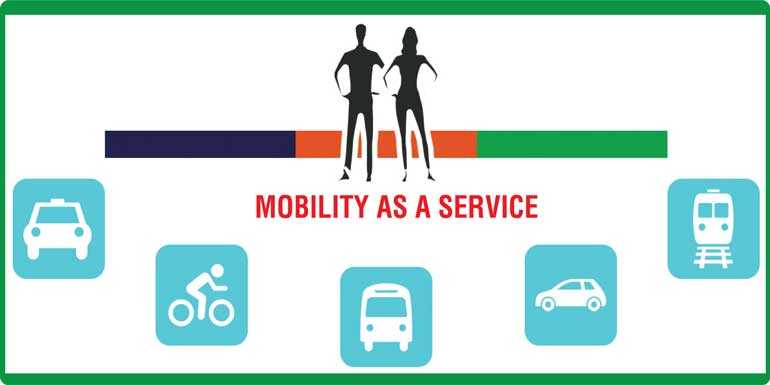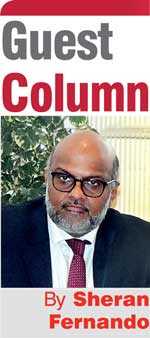Monday Apr 21, 2025
Monday Apr 21, 2025
Thursday, 12 March 2020 00:00 - - {{hitsCtrl.values.hits}}


Can electric shared mobility reduce congestion, pollution and Sri Lanka’s foreign exchange expenditure on fuel? 
Ease of transport is an indicator of economic development of a country or city. It drives convenience of living, which in turn drives economic activity and investment. Every economically successful city has a high quality of mobility.
Similarly, air quality is a significant factor that determines the extent to which people want to live in or invest in a city. Sustainable mobility will help reduce pollution and increase the quality of air in Sri Lanka.
Present situation
Is Sri Lanka’s public transport satisfactory? Sri Lanka’s public transport has not been upgraded over the last three decades, leading the consumer towards ownership or personalised door-to-door solutions. This has caused significant issues in terms of congestion, pollution, and high expenditure on the import of fuel.
Reasons to adopt Sustainable Mobility in Sri Lanka
Managing the mobility of people and goods is one of the country’s toughest environmental and social challenges.
1 Congestion
How bad is congestion in Sri Lanka?
Congestion has led to the reduction in our average speed of commuting in Colombo from 14kmph in 2017 to 8kmph in 2019. It is estimated to further decline to 4kmph by 2035. It has led to a severe decline in
air quality as depicted
in Diagram 2.
2 Pollution
Are vehicles causing increased levels of pollution?
70% of Sri Lanka’s total air pollution is attributed to the transport sector. The chart shows that the air quality in Kandy is classified as ‘Unhealthy’ and Colombo at the level of ‘Unhealthy for Sensitive Groups’. These indices point towards an overall deterioration as congestion further builds. The congestion and resultant pollution are a function of the increase in privately owned vehicles.
The congestion and pollution come from the use of Internal Combustion Engines (ICE), or petrol and diesel. The Sri Lanka Central Bank Annual Report of 2018 shows our expenditure of fuel at $2.9 billion in 2018. This is a significant outflow of foreign currency, causing pressure on our current account.
Solutions
The real problems to be solved are not only transport, but congestion, pollution and cost of fuel imports.
The solutions to be discussed are:
1 Encouraging electric vehicles and discouraging ICE vehicles
2 Encouraging shared ownership and discouraging private ownership
3 Creating a multi-modal digital platform that will allow commuters to use all forms of transport in an integrated manner
4 Upgrade public transport
5 Technology
1 Encouraging electric vehicles and discouraging ICE vehicles
Electric vehicles actually predate ICE vehicles. The reason that ICEs took over the world of transport is that they had longer ranges of travel, given the battery technology available at the time. Today, battery technology has changed significantly. Modern electric vehicles have ranges of over 300km per charge and charging times are plummeting. In a country with an abundant solar resource and relatively short travel distances, EV is very viable.
The rapid decline in the cost of lithium ion batteries that store energy on an EV is another factor that is boosting the viability of EVs. The cost of kWh of lithium ion battery which was $1,000 in 2010 has now declined to $227 in 2016. Tesla claimed to be producing batteries at $190 per kWh and are expected to reach $100 by 2020. The battery is the ‘heart’ of an EV and falling prices really impact the cost of the vehicle. This is how Tesla were able to sell the Model 3 at a starting price of $35,000.
The other factor that is leading to the viability of EV’s is the educed cost of maintenance. An EV has only around 20 moving parts compared to over 20,000 in an ICE. This results in an EV costing very much less to maintain and also having a longer life. It is expected that EV’s will have a lifetime of at least 500,000 miles (804,672 km).
EV’s are noise and pollution free from a running point of view. It is true that the Sri Lankan grid is powered by fossil fuel. However, if one were to assume that all the cars in Sri Lanka were converted to electric, the pollution from powering the grid would be less than the pollution generated by the cars. Also, Sri Lanka has the potential to power EVs via solar power.
Encouraging EVs would need a charging network. Around 2016 when the duty on EVs were low, the charging network did emerge, showing demand drive supply.
2 Encouraging shared and discouraging private ownership
“It is a transportation strategy that allows users to access transportation services on an as-needed basis. Shared mobility is an umbrella term that encompasses a variety of transportation modes including car-sharing, bike-sharing, peer-to-peer ridesharing, on-demand ride services, micro transit, and other modes.”(https://en.wikipedia.org/wiki/Shared_mobility)
A startling study by George Serafeim and David Freiberg revealed that one shared autonomous (driverless) vehicle replaced between nine and 32 privately owned vehicles based on location. The reason for this is that a privately owned vehicle is estimated to be used 4% of the day while a shared mobility solutions vehicle is estimated to be used 40% of the day. A study by Ann Arbour found a shared vehicle fleet could give the commuter instant access to a vehicle using 15% of the number of vehicles compared to private ownership. Ridesharing includes many commuters sharing the same vehicle and hence splitting the transport cost between them. The above statistics show that ride sharing will significantly reduce the number of vehicles on the road.
If the vehicles used for shared mobility were EVs then the reduced maintenance cost, longer life and greater utilisation will synergise and deliver a significant drop in costs. Goldman Sachs estimated that in 2017 there were 15 million shared mobility trips recorded and estimated the figure increasing to 97 million by 2030.
A further economic benefit of ride sharing is that ride-hailing apps such as Uber allow privately owned vehicles to also provide a public function via the app, again supporting the efficiency of asset utilisation.
The data also shows that ride-sharing can also reduce the total demand for motor vehicles, which is a point that will be developed in a future article.
A lever to help the Government push commuters from owned to shared mobility is through the administration of city entry charges and congestion chargers that are high on privately owned transport and low or exempt on shared mobility service
providers.
3 Multi-modal digital platform
The multi-modal digital platform is often referred to as Mobility as a Service (MaaS) or Transport as a Service (TaaS). MaaS aims to provide an alternative to the use of a private vehicle by giving commuters access to various forms of transport solutions in one space with a single payment option. MaaS makes transport more convenient, more sustainable, reduces congestion and can possibly make travelling  cheaper for the commuter. There are many examples of such platforms already in use in Europe.
cheaper for the commuter. There are many examples of such platforms already in use in Europe.
The concept of MaaS is even wider than the diagram shows. The platform can offer every mobility solution fathomable including parking, ride-hailing, ride-sharing, using land rail, sea and underground transport services.
The platform additionally allows the commuter to switch between transport services as required. For example, a commuter on a MaaS app who is driving could be advised to park his car at a tube station and take a tube to reach his destination faster. He could also book his parking place and pay for it via the platform itself.
MaaS is a tool that not only promotes the adoption of shared mobility as opposed to privately owned mobility, but also promotes the use of public transport, integrating it and other shared mobility solutions to give the commuter a door-to-door solution.
MaaS platforms are widely used in Europe and America. India today uses no less than 40 such platforms.
4 Upgrading public transport
The Sri Lankan public transport badly needs upgrading. The upgrade needed is both hard – in terms of assets – and soft, in terms of customer service and usage experience.
Ideally, the buses that operate inter-city should be converted to electric or at least hydrogen. Both options are available for conversion. Intra-city buses need to be made more comfortable.
The availability of a platform (MaaS) will allow commuters to plan times, book seats, reserve onward transport options and hence make the public transport more user friendly.
5 Goods transport by train and water
Trains in Sri Lanka is absolutely under-utilised for public transport. “However, the goods kilometrage decreased by 17.3% to 119.8 million MT km in 2018, compared to 144.8 million MT km in 2017, reflecting the inefficiencies arising from trade union action, train cancellations and the shortage of locomotives for goods transportation activities,” (Central Bank Annual
Report 2018). There are around 350,000 lorries operating in Sri Lanka, with 9,300 new ones being registered in 2018.
If at least 50% of this transport could be done by train, it would create a positive impact on both congestion and pollution. The rail connectivity from the Port of Colombo could be revitalised and utilised to a much greater extent.
There is also a possibility of using internal waterways and regional harbours for the transport of goods within the country.
6 Technology
Technology forms an integral part of the recommended solution. The technology of automatically identifying privately owned vehicles and levying a city entry charge on them and a further congestion charge is imperative to drive the recommended
policies.
Further, if these charges cascade for ICE vs. electric, this would again encourage the adoption of EVs for both shared and private mobility.
Technology is also needed to determine the number of people travelling in a vehicle, be it private or otherwise, and again alter the levy, allowing the Government to discourage single commuters using a vehicle.
This technology is used in every developed country in order to manage traffic and influence congestion in cities.
Conclusion
Aristotle said, “The whole is greater than the sum of its parts.” In other words, when individual parts are connected together to form one entity, they are worth more than if the parts were in silos.
The discussion above shows that the problems of congestion, pollution and high expenditure on fuel could be effectively addressed by policy aimed at encouraging shared mobility and electric
vehicles.
The analysis also shows a significant synergy in adopting the recommended policies together. For example, the benefits of shared mobility multiply when dealing with electric vehicles.
The writer is a co-founder of Innosolve Ltd., a start-up dedicated to introducing sustainable mobility solutions in Sri Lanka. He is an economist by training, with wide commercial experience including 20 years in the automotive industry, and is an alumni of Harvard Business
School (OPM53).